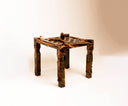Silk Road Summer Sale — Use code MIDSUMMER10 for 10% off all products
Hi everyone!
I’m Yamini Banker, and welcome to The Silk Road Stories, where we dive into the stories of artists, designers, and artisans whose creativity shapes our world. Today, I’m thrilled to introduce a special guest and someone very close to the heart ofThe Silk Road Paris, our very own co-founder, Soumil Sharma! Soumil’s journey is a perfect blend of innovation and heritage, and today, he’s sharing how his path led him from India to the creative epicenter of Paris. Let’s dive in!


Could you share a bit about yourself and your background with us?
I'm Soumil Sharma, originally from Jammu and Kashmir, India, and currently based in Paris. I'm a designer, researcher, architect, and co-founder of The Silk Road Paris. I came to Paris in my early 20s to pursue a career in architecture. My passion lies in design, objects, and materials, and how they influence people. My work is deeply inspired by my Indian heritage, focusing on materiality, traditional craftsmanship, and the cultural identity of design while also exploring future possibilities.
Can you tell us more about how your family background and cultural heritage have influenced your journey into architecture and design?
While architecture and object design weren’t directly passed down through my family, I’ve always been surrounded by stories of craftsmanship in India. I come from a family where my parents were in government service—my father was a banker and my mother a teacher—in a family where creativity was more a hobby than a profession. When I was very young, I wanted to be in animation and design (always a creative field), but my brother and father introduced me to the idea of architecture as a profession, which is a mix of both worlds: creative and technical. Since then, I have been in love with architecture and design. In the end, I feel it was not the craft but the idea that was passed down through my family generations, who were not able to take creative fields as their profession because of the opportunities that didn't exist. Along with that, India has always had a cultural and religious relationship with its objects, which inherently gave me an appreciation for handmade objects passed down through history, and this has deeply influenced my approach to design.
How do you think living or working in Paris has shaped your perspective on art and craftsmanship?
Living in Paris has given me a deeper appreciation for craftsmanship, especially the way tradition, preservation, and innovation can coexist. The city’s long history of artisans and its vibrant design community push me to think critically about my own work, encouraging me to bridge the gap between past and future.
What is your personal relationship with Paris?
Living in Paris has been transformative. I owe to this city wherever I am now. There was an early time when the city I had an idea of before moving didn't match my expectations. It took time to understand and appreciate. It's a city rich with art, design, and history, which constantly inspires me. The city taught me through the struggles I had in my early years—the language, the new culture, and a new vision. It takes time for one to really appreciate a new home and learn. Inherently, Paris has also taught me the value of preservation. Living and breathing in a city that has been carefully preserved for hundreds of years made me appreciate my roots and values even more. It allows me to understand my cultural heritage with a global perspective. It has been the city where artists and creatives come to find inspiration; now I understand a bit what drew them in. It's not just the beautiful architecture, the Seine, or the food; it's the sense of being somewhere that you don't belong to and then finding yourself. This is part of what makes it so beautiful to explore.
What are your hobbies apart from design and architecture?
I am an avid chess player. It has been a beloved hobby of mine since middle school. We had a chess set at home, and I started playing regularly from a young age. It's not just about the strategy for me; playing chess helps me relax and take my mind off work and everything else. It’s a great way to unwind and gives my brain a different kind of focus. I enjoy getting lost in the game, and it offers a refreshing break from my daily routines.
What are the most important skills or techniques in your craft?
I have been working on experimental objects for some time. For me, understanding materials, space, and scale is key—how they interact, how they can be manipulated, and how they affect the final product. Staying rooted in traditional ideas and practices while being open to modern interpretations is also crucial. Additionally, giving a soul, a narrative to a creation, is important. Without it, design can feel lifeless, as humans naturally seek meaning in everything.


How do you see the future of traditional craftsmanship?
I see traditional craftsmanship evolving by maintaining its core values while integrating modern materials and practices. The future is about sustainability—adapting ancient skills to contemporary needs. In terms of fashion and design, traditional craftsmanship aligns with conscious, slow fashion, where products take time to produce and are made specifically for you. This allows people to reflect on their choices, which is incredibly important in today’s fast-paced world.
What are some of the biggest challenges you face in your craft?
One of the biggest challenges is balancing tradition with innovation—finding ways to preserve cultural identity in design while creating something fresh, relevant, and forward-thinking. The research required to initiate even a concept can be daunting, but it is essential to ensure authenticity and depth.
Paris has a long history of artisans and craftsmen. How do you feel connected to that heritage?
I feel deeply connected to Paris’s artisan heritage because it parallels Indian craftsmanship in many ways. Both cultures have a long-standing respect for the story and skill behind each object. Being part of a tradition where every creation has meaning beyond its function is something I resonate with, and it inspires me to carry this forward in my own work.
How do you think living or working in Paris has shaped your perspective on art and craftsmanship?
Living in Paris has given me a deeper appreciation for craftsmanship, especially the way tradition, preservation, and innovation can coexist. The city’s long history of artisans and its vibrant design community push me to think critically about my own work, encouraging me to bridge the gap between past and future.
How has the Silk Road inspired you in your journey?
Co-founding The Silk Road Paris has been a significant part of my journey, helping me explore new facets of creativity and fostering an inspiring exchange of ideas. Working alongside other designers has been incredibly motivating, and our platform has amplified their voices. I’m excited to continue supporting creative talent through the silk road itself and build stronger communities.
Credits: Interview by Yamini Banker. Personal images of Soumil Sharma have been used, showcasing him wearing his father's pants, passed down from the '90s, along with pieces from Margn.




















